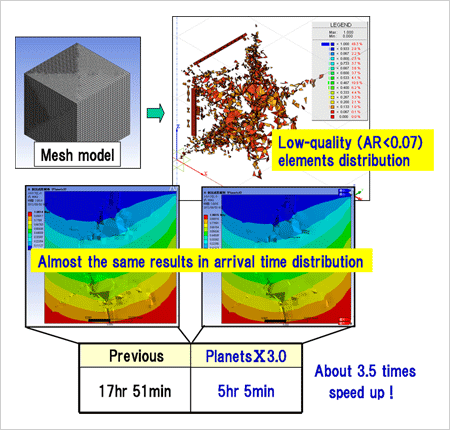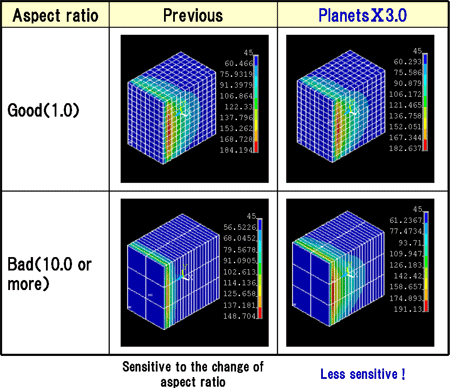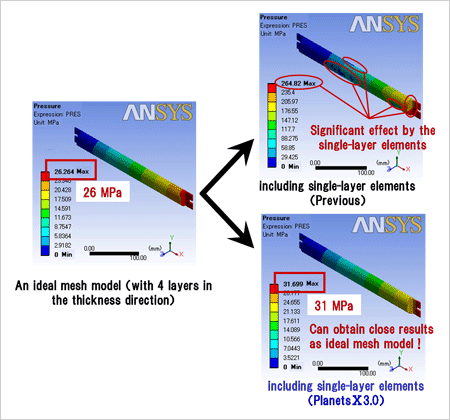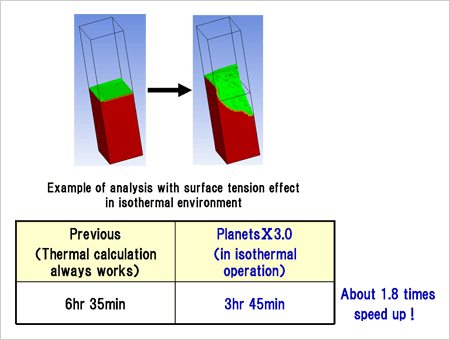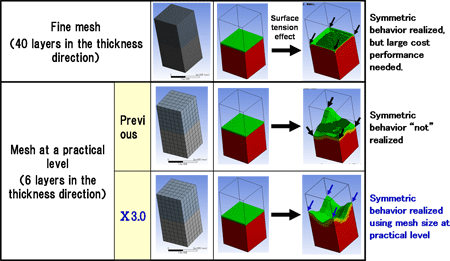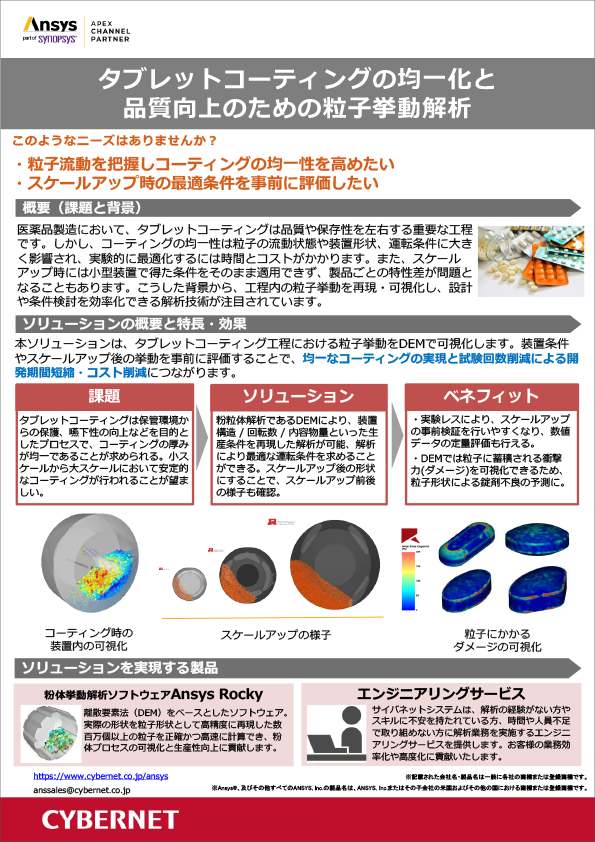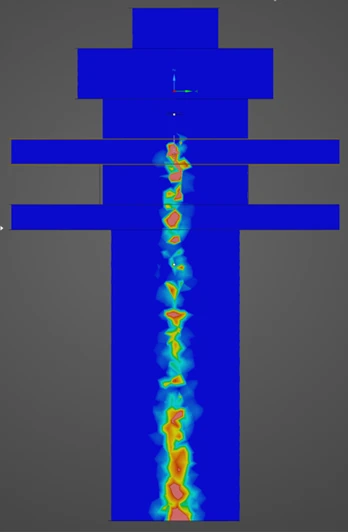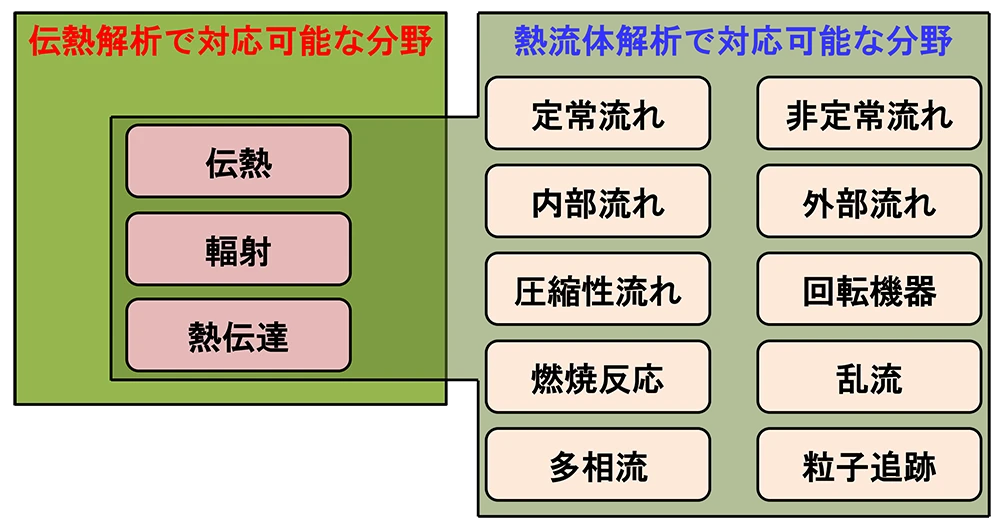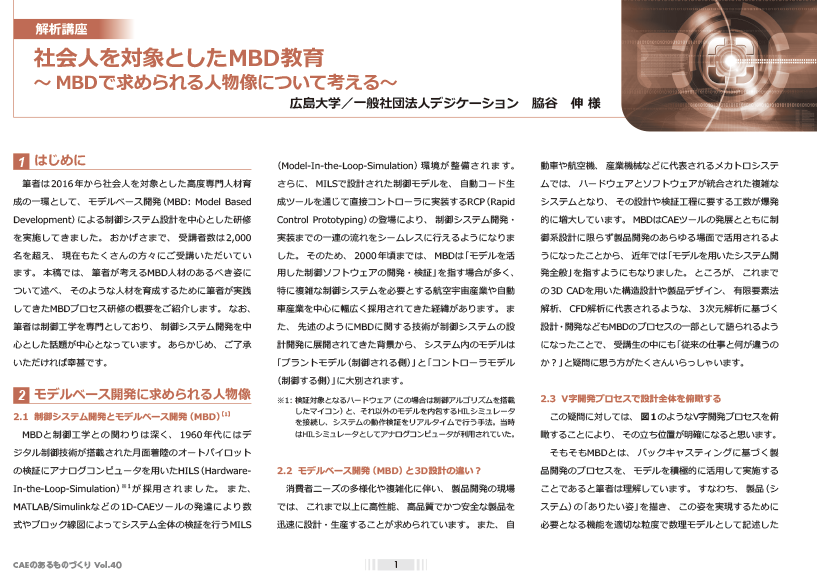Release Information
PlanetsX 3.0 Release Information
PlanetsX 3.0 was released in February 2013.
The following three items are the Release Highlights.
- 1. The solver performance has been improved
- The solver speed was accelerated by reviewing the time step interval
- Memory consumption was reduced
- Calculation accuracy improvement 1: Corresponding to elements including bad aspect ratios in the models
- Calculation accuracy improvement 2: Corresponding to a single-layer element by substituting a theoretical value approximately
- Function addition of Isothermal analysis
- Improvement of asymmetric flow behavior by surface tension effect
- Corresponding to computational double precision
- 2. Corresponding to Ansys 14.5
- 3. License management system has changed to FlexNet Publisher
Detail of PlanetsX 3.0 Release Highlights
1. The solver performance has been improved
Comprehensive improvement in the performance of underlying quality, such as precision, efficiency and robustness, was achieved by an overall review of solver source code. This allows PlanetsX to be used as an all-in-one tool of injection molding analysis which obtains high accuracy results at high speed.
The time step interval, during which the flow front progresses in one step, is determined by the size and the shape of elements. Therefore, there are cases where the time step interval becomes very fine depending on the mesh model. Especially, it becomes evident in the meshes including a lot of low-quality elements (with bad aspect ratios) locally. PlanetsX 3.0 improved this point; to escape excessively fine interval generation, PlanetsX 3.0 leaves the elements with too bad aspect ratios (less than 0.07) out of decision about the time step interval. Actually as shown in the figure below, one obtains almost the same results of arrival time distribution even in such removal with shorter calculation time. When the product model is complicated, it will be inevitable to get low-quality elements. However, thanks to this improvement, it can be possible to obtain a reasonable solution quickly even in this kind of situation. (Note 1)
(Note 1) When the model consists of high-quality elements, the effect of speed-up may be limited.
Memory consumption was reduced by reviewing the memory administration process inside the solver. As a result, PlanetsX 3.0 achieved memory reduction of 70`80% at most. Also, by this achievement it can analyze a model with approximately 2 millions elements on a 32bit machine (where its maximum memory 2.0GB is available for total memory size 5.6GB in this model). In the environment of currently a mainstream 64bit machine, one can more flexibly correspond even to further fine mesh analysis.
In the previous solver, the meshes with low quality (bad aspect ratios) led to poor calculation accuracy in temperature analysis results. This is due to a problem with applying control volume method to bad aspect-ratio elements in the solver. PlanetsX 3.0 was successful in keeping the calculation accuracy even in meshes containing bad aspect-ratio elements. Such elements easily appear especially in the analysis of thin and large models like a plate shape. Thanks to this improvement, high accuracy results can be achieved in the analysis of those models.
In the previous version of PlantesX, if a mesh model contains some single-layer elements, which have only one element in the thickness direction, it led to reduced calculation accuracy of results. This is because the resin flow cannot be accurately represented in the single-layer part. In the flow analysis, therefore, it is recommended to create generally at least 4 layers of elements in the thickness direction. However, it is difficult to create such ideal meshes without single-layer elements in the models that are very complicated shapes or very thin shapes. In PlanetsX 3.0, better results can be obtained by substituting the approximate theoretical value for evaluating the resin flow in single-layer elements. As shown in the figure below, it gets close results of pressure distribution as provided with an ideal mesh with 4 layers or more. However, it is noted that this result does not have adequate accuracy in comparison with the case of ideal mesh. (Note 2)
(Note 2) This improvement is aimed to keep calculation accuracy to some extent even in the case that single-layer elements exist in the mesh model. Therefore, it should be noted that the use of a single-layer element is not recommended.
To do efficient evaluation of the Isothermal molding like a curing process, which often needs long molding time in the same temperature, PlanetsX added a new function of the isothermal analysis. The calculation time in this operation is reduced by omitting the calculation process of temperature.
The surface tension becomes dominant in small-size models or low-viscosity resin. In the previous solver, those cases have tendency to result in asymmetric flow behavior due to large numerical errors when coarse meshes are used. In PlanetsX
3.0, numerical errors are reduced by a smoothing method so that symmetric flow behavior can be maintained at a practical level.
Accumulation of numerical errors (like a cancellation of significant digits) due to iterated calculations was minimized by adopting computational double precision in the treatment of numeric data for the solver. This allows great improvement in the overall accuracy of PlanetsX, since the change to double precision from single one affects all parts of the solver.
2. Corresponding to Ansys 14.5
PlanetsX 3.0 corresponds to the newest version of Ansys 14.5.
3. License management system has changed to FlexNet Publisher
License management system was changed to FlexNet Publisher. Along with this, administration of license for the solver was changed from a hardware management using USB dongle to a management using license file.
関連情報
関連する解析事例
MORE関連する資料ダウンロード
MORE-
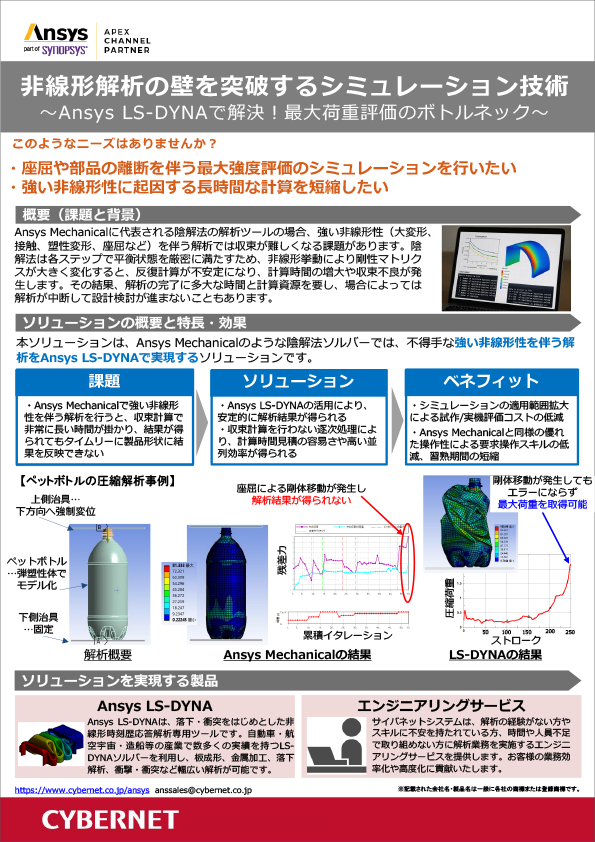
非線形解析の壁を突破するシミュレーション技術
~Ansys LS-DYNAで解決!最大荷重評価のボトルネック~
-

事例でご紹介!流体解析分野のエンジニアリングサービス ~解析業務の委託・立ち上げ支援・カスタマイズによる効率化など~
-
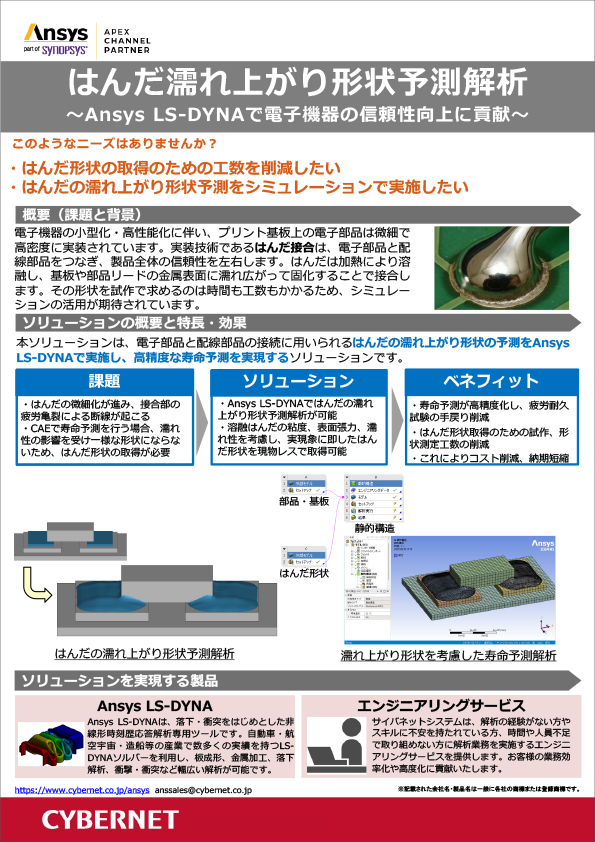
はんだ濡れ上がり形状予測解析
~Ansys LS-DYNAで電子機器の信頼性向上に貢献~
-
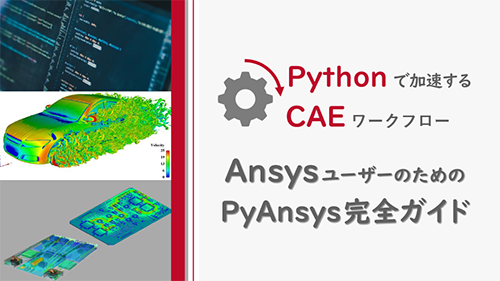
Ansys ユーザーのための PyAnsys 完全ガイド
Pythonで加速するCAEワークフロー
-
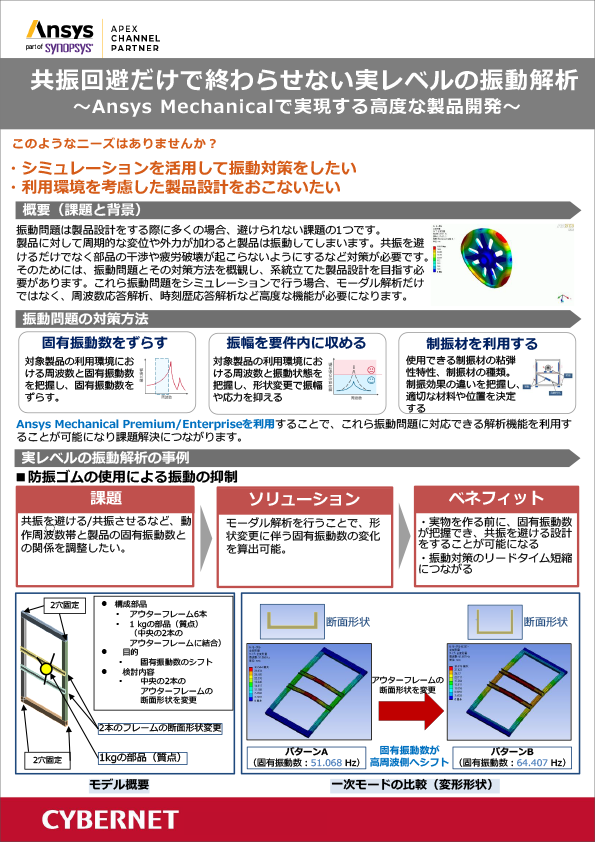
共振回避だけで終わらせない実レベルの振動解析
~Ansys Mechanicalで実現する高度な製品開発~
-
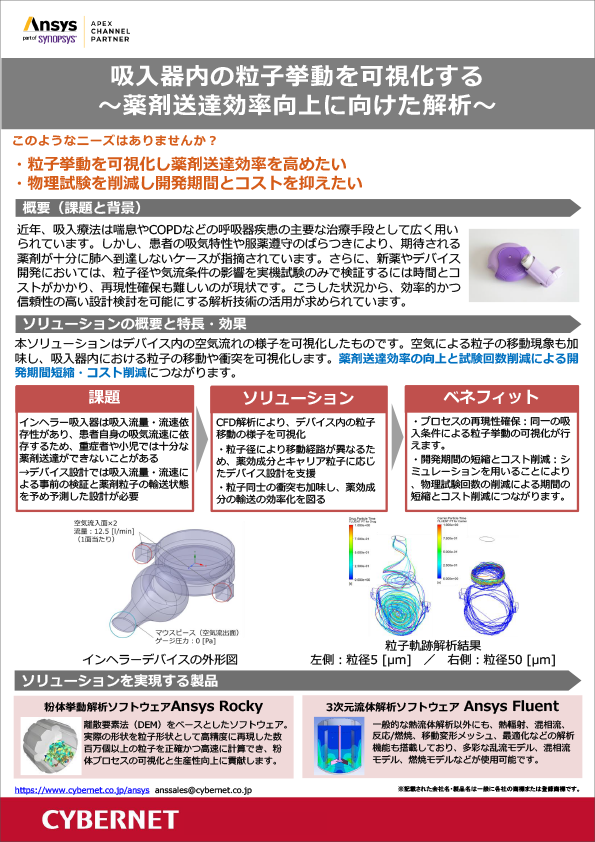
吸入器内の粒子挙動を可視化する
~薬剤送達効率向上に向けた解析~
-

医薬品バイアルの温度挙動解析
~保管環境の影響把握と品質維持に向けた可視化アプローチ~
-

そのFDTD計算、もっと速くできる!Lumerical+GPUでフォトニクス解析に革命を




